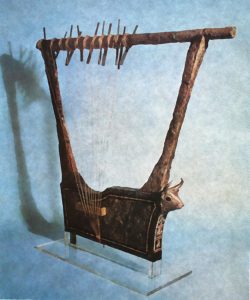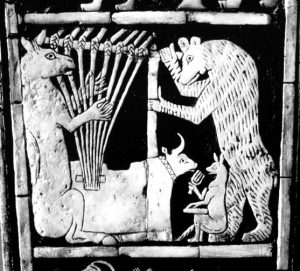Peter Pringle plays a replica of the Sumerian silver lyre of Ur.
From his own explanation of how this replica was made:
In 1929, there were five lyres discovered in a royal burial pit in the ancient Sumerian city of Ur (in southern Mesopotamia) by the British archeologist, Sir Leonard Woolley. Unfortunately, these instruments were simply laid in the ground nearly 5000 years ago, and covered over with earth so they were completely crushed flat and any organic material used in their construction quickly rotted and turned to dust. Two of the lyres, however, had been made of wood covered with a layer of silver sheeting about the thickness of a tin can. The wood beneath the silver disintegrated but the silver itself did not, although after 5000 years it became heavily oxidized and turned black. The archeologists poured melted wax over what was left of the lyres and when the wax hardened they carefully lifted them out of the ground. Just to put things into perspective, these instruments were made nearly 2000 years before Stonehenge and the Great Pyramid of Giza.
(…) I had wanted to have a replica of the silver lyre for years, so in the mid 1990’s I wrote to the world famous and highly respected assyriologist, Dr. Anne Kilmer, and sought her advice. She kindly wrote back and sent me all sorts of valuable information that she had accumulated on the subject over her many years of study. It took me nearly 20 years to getting around to building the lyre, but here it is! I feel I should also acknowledge the contribution of the wonderful Professor Richard Dumbrill, whose writings and videos on Sumerian music in general (and the silver lyre in particular) were invaluable.
(…) According to Leonard Woolley’s original notes, there was no trace of a wood backing for the two faces of the silver soundboard, so the front and back of the resonator were two pure silver plates, and not made of wood overlaid with silver. This is a detail that has been overlooked by many luthiers who have attempted to reconstruct this instrument, but it is a factor that would have had a tremendous influence on the sound of the finished lyre. It would have been comparable to the difference between the sound of a classical guitar and the louder, far more resonant timbre of a steel dobro.
The ancient ruins of Ur.








